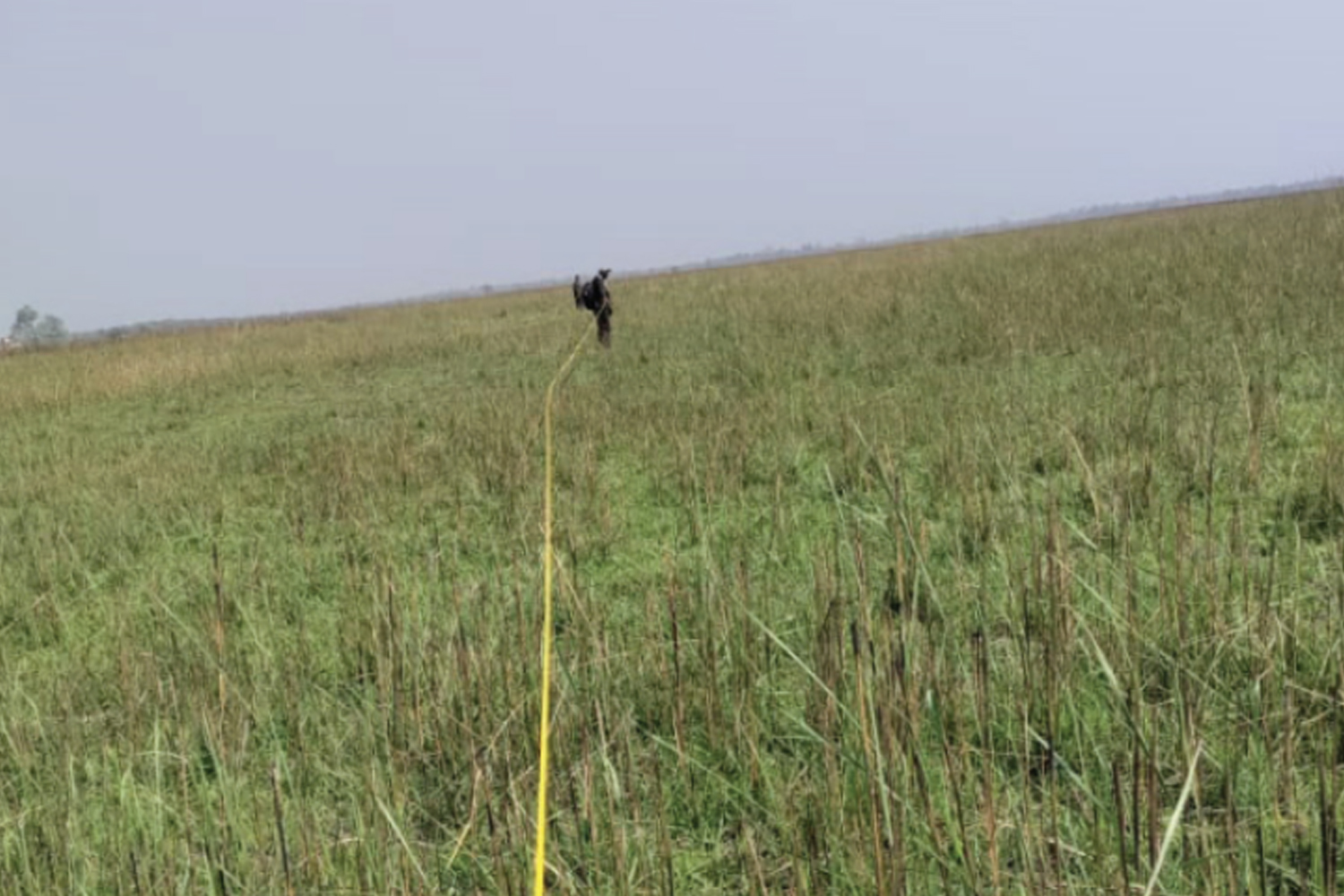National
Shuklaphanta counts endangered Bengal floricans
Last year’s survey in the national park found five of these critically endangered ground-nesting birds, which are now confined to Nepal, India and Cambodia.
Bhawani Bhatta & Kamal Panthi
The Shuklaphanta National Park started counting rare and endangered Bengal floricans (Houbaropsis bengalensis), locally known as Kharmajur, from March 26.
Earlier, counting was done by making tree houses and watch towers, which is called the ‘vantage point method’, but this year both ‘sweep method’ and ‘vantage point method’ are being used to count the bird species.
According to Manoj Air, conservation officer at the park, under the sweep method, a long rope is dragged by people through grasslands and bushes, causing birds to take flight. The distance between each person dragging the rope is around 50 metres.
“People are posted at different places in the park using the vantage point method every day, and the sweep method is being used for two days in the interval of two days. The count is held in three phases. The first phase of the count was held from March 27 and March 28, the second started on March 31 and continue until April 1, and the third will be conducted on April 4 and April 5, where the assigned people will search and count the birds in Shuklaphanta grassland, Kariyaphanta and Hirapurphanta grasslands in the Shuklaphanta National Park along with the grasslands of the buffer zone areas,” said Air.
According to last year's counting of the park, a total of five Bengal floricans—three males and two females—were reported in the park.
“The counting is held in the mornings and evenings using both methods when the birds are more active. This is also the breeding season for the Bengal florican. During this time, the males engage in elaborate courtship displays, performing dances, to attract females, jumping up and down,” said Hirulal Dagaura of Bird Conservation Nepal, who has been assigned to count Bengal floricans.
According to Dagaura, nowadays males can be seen easily, and there are good possibilities of sighting both males and females together. Similarly, along with Shuklaphanta, Chitwan National Park and Koshi Tappu Wildlife Reserve have also started counting Bengal floricans simultaneously.
“The annual counting of Bengal floricans has been going on in the Shuklaphanta National Park since 2013, and at that time there were seven Bengal floricans in the park. Before 2013, a counting was also conducted in 1996, and at that time, the number of this rare bird was 17 in the park. When the park officials learned that the number of Bengal floricans was decreasing, they started conducting annual counting for better protection and conservation,” Dagaura added.
According to Shuklaphanta National Park, 20 skilled technicians have been hired to count the rare birds. Among them, five people will continuously monitor some specific locations where the chances of finding the rare birds are higher.
Conservation officer Air said that Bengal floricans are mainly found in the Shuklaphanta, Chitwan National Park, and Koshi Tappu areas of the country, and only 27 birds of this species have been seen in these places.
According to Hem Sagar Baral, a renowned ornithologist and conservationist, even though the number of Bengal floricans countings in protected areas is very low, the estimated number of these rare birds in the country is around 100.
The Department of National Parks and Wildlife Conservation considers Bengal floricans to be a highly threatened and rare ground nesting bird species inhabiting only Nepal, India, and Cambodia, with a world population of only 250 to 999.
“This bird species has become extinct in several countries over the past few decades, leaving it confined to just three countries. Bengal florican is also an indicator of the grassland health. These birds feed on insects, including those that carry diseases and destroy plants and crops,” said Baral.
“The area surrounding these bird’s nests is surprisingly clean. This bird is also beneficial for farmers, as it lives in the grasslands of parks and forest areas during the dry season and goes to agriculture fields during the rainy season,” Baral added.
Baral said that the number of these birds is decreasing every year, and the main reasons are poor management of grasslands, a higher number of males than females, illegal hunting, and poaching. Similarly, this bird builds its nest on the ground, so it is also vulnerable to other predators. “Studies and research have not been done to give accurate results about Bengal florican and its habitat for conservation,” said Baral.
Bengal florican is classified as a critically endangered species in the International Union for Conservation of Nature Red List due to its small and rapidly declining population caused by widespread loss of grassland habitat within its range.

Rhino count begins in Bardiya National Park
The Bardiya National Park (BNP) has commenced ‘rhino monitoring’ in the park forests and its vicinity to find out the actual status of the endangered species. A team of BNP employees, Nepal Army personnel and technicians from the National Trust for Nature Conservation has been mobilised for monitoring rhinos.
According to the BNP administration, 10 captive elephants are being used in the monitoring that continues for two weeks. “The rhino monitoring will be conducted mainly in the Babai valley and the Karnali river banks,” said Puroshottam Wagle, assistant conservation officer at the BNP. According to him, the monitoring will be conducted by dividing the areas into six blocks.
The national park monitors rhinos every year. As per the latest rhino census held in 2022, Bardiya hosts 38 rhinos. Among them three rhino calves were either killed by tigers or died due to natural causes.
It is estimated that around a dozen rhinos moved to India’s Katrarniaghat Wildlife Sanctuary, which borders Nepal. Various Indian media reported that around a dozen rhinos entered the sanctuary in India. “We don’t have any evidence regarding the rhinos that entered Katarniaghat. The ongoing monitoring will make things clear,” said Wagle.
The BNP, according to conservationists, is an important rhino habitat after Chitwan. Rhino poaching has not been reported in Bardiya for the past 15 years. “There has been zero-poaching in Bardiya for a long time due to tight security and effective conservation works. The local communities also help in rhino conservation in Bardiya,” said Ashok Ram, chief conservation officer at the BNP.




 8.12°C Kathmandu
8.12°C Kathmandu
















